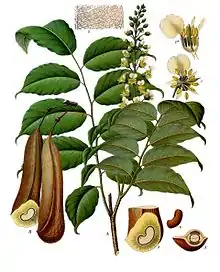Myroxylon balsamum
Myroxylon balsamum, Santos mahogany, or Peru balsam is a species of tree in the family Fabaceae. It is native to tropical forests from Southern Mexico through the Amazon regions of Peru and Brazil at elevations of 200–690 meters.[1] Plants are found in growing in well drained soil in evergreen humid forest.
| Myroxylon balsamum | |
|---|---|
 | |
| Scientific classification | |
| Kingdom: | Plantae |
| Clade: | Tracheophytes |
| Clade: | Angiosperms |
| Clade: | Eudicots |
| Clade: | Rosids |
| Order: | Fabales |
| Family: | Fabaceae |
| Genus: | Myroxylon |
| Species: | M. balsamum |
| Binomial name | |
| Myroxylon balsamum (L.) Harms | |
| Synonyms | |
| |
Description
The tree is large slow growing, reaching 45 metres (148 ft) in height. Crown is round with dense foliage and the bark is yellowish with a pungent odor. Leaves alternate, petiolate, 8–20 centimetres (3.1–7.9 in) including the petioles, the petioles 1–4 centimetres (0.39–1.57 in) long, and the rachis 5–15 centimetres (2.0–5.9 in) long. The rachis and petioles are pubescent and terete. Leaflets are acute to acuminate at the apex, obtuse at the base, glabrous, with an entire margin and glandular oil dots.
Plants bloom 5 years from seeds during the months of February to June. Flowers are white, pubescent and has around 10 stamens. The fruit is a flat winged pod, narrowly obovate 8 centimetres (3.1 in) long 1–2 centimetres (0.39–0.79 in) wide, yellow to brown when dried and drop around November to January.[2]
 Trunk
Trunk Limbs
Limbs Leaves
Leaves Leaves
Leaves
Subspecies
- Myroxylon balsamum var. balsamum
- Myroxylon balsamum var. pereirae
- Myroxylon balsamum var. punctatum
Uses

The resin extracted from the trunk is known as Balsam of Peru. The extraction process is artisanal. It begins with the heating of the bark so that its resin concentrates on the burn. After a few days the resin-wet skin is removed and a cotton cloth is glued on the wound to extract even more sap. This cloth is left for 15 more days. It is then removed and twisted in a press. After obtaining the resin, it is purified of impurities with fire.
This already purified product is marketed among a series of intermediaries and exporters, its destinations being Germany, the United States of America, England and Spain, where it is used in the manufacture of cosmetics and medicines (for diseases of the skin, bronchi, lungs and airways, and in the treatment of burns and wounds)[3]The tree has been planted for Balsam production in West Africa, India, and Sri Lanka.
The wood is reddish and has interlocked grain, which gives it a strong ribbon-like pattern, and logs produce a large amount of knot-free lumber. The wood has a Janka hardness of 2,200 lbf (9,800 N) and is somewhat resistant to fungal decay. Myroxylon balsamum wood is used for flooring, furniture, interior trim, and heavy construction.[4]
Myroxylon balsamum is often use as a shade tree in coffee plantations.[2]
References
- Bagnatori, Ângela; Lewis, Gwilym P.; de Freitas, Vidal; Goulart, Ana Maria (2015). "A revision of the genus Myroxylon (Leguminosae: Papilionoideae)". Kew Bulletin. 70 (4): 48. doi:10.1007/s12225-015-9604-7. ISSN 0075-5974. S2CID 26434950.
- Vozzo, J.A.; United States. Forest Service (2002). Tropical Tree Seed Manual. Agriculture handbook. U.S. Department of Agriculture, Forest Service. p. 582-583. Retrieved 2020-09-21.
- Fuentes, R. E. (1993). "El Bálsamo en El Salvador: Una especie con potencial económico". Revista Forestal Centroamericana. 6: 38–41..
- "Santos Mahogany - Lumber Identification (Hardwood)". The Wood Database. 2010-04-14. Retrieved 2020-09-21.
External links
 Media related to Myroxylon balsamum at Wikimedia Commons
Media related to Myroxylon balsamum at Wikimedia Commons Data related to Myroxylon balsamum at Wikispecies
Data related to Myroxylon balsamum at Wikispecies
